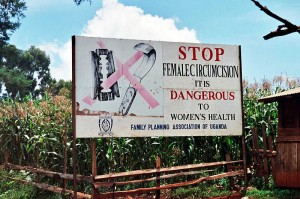 I have just finished reading Waris Dirie’s autobiography “Desert Flower” in which she describes her circumcision and the continued agony it caused her until she had remedial surgery. The pros and cons of male circumcision are well known but few people are aware of the practice of female circumcision. It was definitely a shock to me when I first heard about this practice several years ago.
I have just finished reading Waris Dirie’s autobiography “Desert Flower” in which she describes her circumcision and the continued agony it caused her until she had remedial surgery. The pros and cons of male circumcision are well known but few people are aware of the practice of female circumcision. It was definitely a shock to me when I first heard about this practice several years ago.
Dirie Waris was 5 when she was circumcised without anaesthetic by a gypsy woman with an unsterile razor blade in her native country Somalia. She was subjected to the severest form of circumcision, called infibulation, where the clitoris, labia minora and most of the labia majora are removed and the vaginal opening is sewn up, leaving only a small hole for the release of urine and menstrual blood. As Dirie Waris points out, “the short-term complications are shock, infection, damage to the urethra or anus, scar formation, tetanus, bladder infections, septicaemia, HIV and hepatitis B. Long-term complications include chronic and recurrent urinary and pelvic infections that can lead to sterility, cysts and abscesses around the vulva, painful neuromas, increasingly difficult urination, dysmenorrhea, the pooling of menstrual blood in the abdomen, frigidity, depression and death.”
The practice of female circumcision is widespread in the Middle East and Africa. It is estimated that currently 140 million women in the world have been circumcised. With greater migration the practice is being exported to Western countries causing Sweden, the USA, the UK and Australia to review their laws.
Last month, the United Nations General Assembly passed a resolution urging countries to ban the practice of female genital mutilation, calling it an “irreparable and irreversible abuse.” The Secretary General of the Organisation of Islamic Cooperation, Ekmeleddin Ihsanoglu, has also urged countries to abolish female genital mutilation, saying the practice was against Islam and human rights.
However, eradication will be difficult as it will require a cultural change backed up by religious and tribal leaders as well as legislators. In many countries women must  marry to survive as they have no other career options and lack education. Men refuse to marry women who have not been circumcised. Infibulation is performed to guarantee that a bride is intact, i.e., a virgin; the smaller her opening, the higher the bride price. Thus circumcision is linked to a woman’s value as being culturally and social acceptable and clean, and consequently to her ability to marry.
marry to survive as they have no other career options and lack education. Men refuse to marry women who have not been circumcised. Infibulation is performed to guarantee that a bride is intact, i.e., a virgin; the smaller her opening, the higher the bride price. Thus circumcision is linked to a woman’s value as being culturally and social acceptable and clean, and consequently to her ability to marry.
The procedure takes away a woman’s sexual pleasure and is seen as a way to ensure women are faithful to their husbands – although men are not expected to be faithful to their wives. Perhaps if women could enjoy sex rather than being in agony during intercourse their husband would gain greater pleasure and not have the urge to wander. A woman’s loyalty is not gained through brutality. It comes from the heart and mind, not from her genitalia.
The practice is steeped in tradition and ancestral worship. There are records of female circumcision dating back to 25BC though it is unclear when and why the practice started. In some societies it’s a rite of passage though it’s hard to justify such a reason when a child is 5.
The practice continues due to fear and the need to conform in a patriarchal society. The notion that women are damaged goods once they have had sex causes great suffering to women worldwide. It is a cultural belief that needs to be challenged in all societies if the human rights of women are to be improved.
Dirie Waris became an ambassador to the UN to join the fight to stop female circumcision. In the conclusion to her book she states “I don‘t blame my parents…. My mother has no say….because as a woman she is powerless to make decisions. She was simply doing what had been done to her…My father was completely ignorant of the suffering he was inflicting on me; he knew that in our Somalian society, if he wanted his daughter to marry, she must be circumcised or no man would have her. … But just as we know today that we can avoid disease and death by vaccination, we know that women are not animals in heat, and their loyalty has to be earned with trust and affection rather than barbaric rituals. The time has come to leave the old ways of suffering behind.”
Image Credits
Photo #1: “Campaign Road Sign Against Female Genital Mutilation” – Wikipedia image
Photo #2: U.S. Department of State Photo


The following was recently aired on Australian TV giving different perspectives on this issue http://www.sbs.com.au/insight/episode/watchonline/514/Clear-Cut
Amanda: Thank you for this disturbing and thought-provoking article. It is so distressing to learn that in many places in the world women are still treated as commodities rather than as human beings fully equal to men in intelligence and creativity, with the same rights to respect, dignity, and security. Ms Dirie is truly a brave soul and I wish her great success in her campaign to end the ignorance that leads to this brutal, inhuman practice.